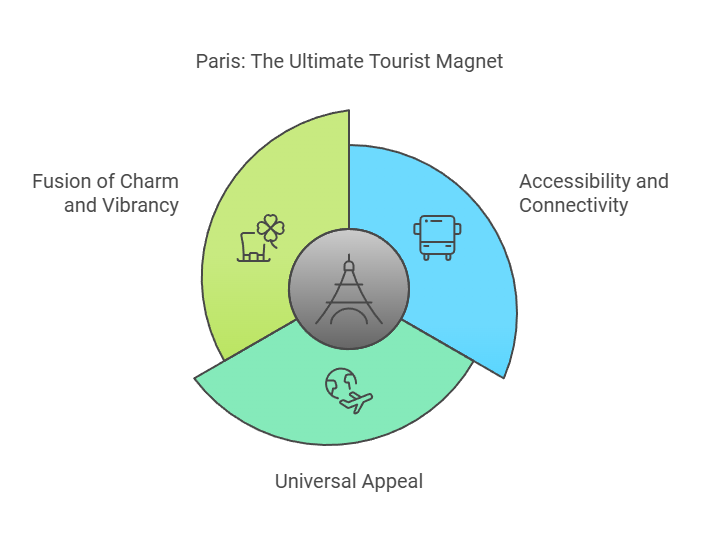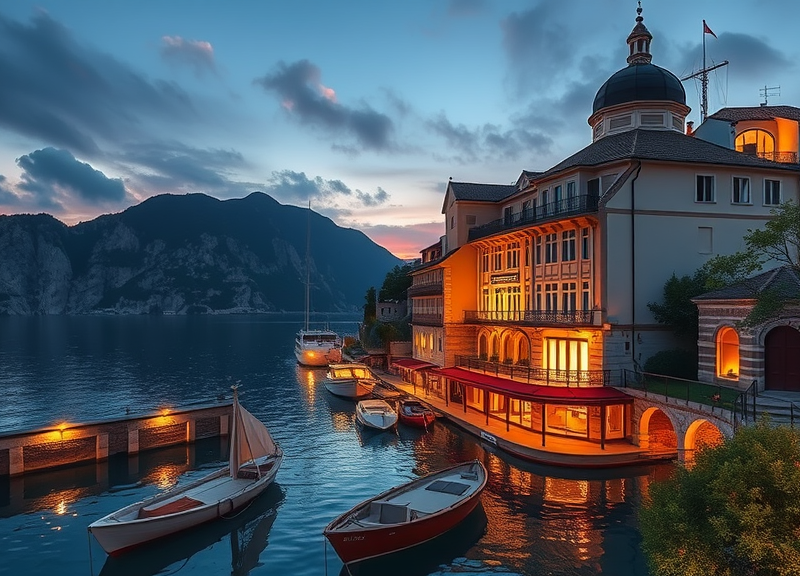When it comes to planning a European adventure, one question often emerges: What is the #1 tourist spot in Europe? While the continent offers a treasure trove of breathtaking destinations, the crown undeniably belongs to Paris, France. Known as the City of Light, Paris has consistently ranked as the most visited city in Europe, attracting an astounding 19.4 million international visitors in 2022.
So, what makes Paris the ultimate travel destination? In this blog, we’ll explore its iconic landmarks, vibrant culture, and unique charm. From the grandeur of the Eiffel Tower to the artistic allure of Montmartre, we’ll uncover why Paris stands out not only as a European gem but also as a global cultural powerhouse.
Why Paris Is the Top Destination
Paris’s reputation as Europe’s premier tourist spot is no accident. The city offers an unparalleled mix of history, art, fashion, and gastronomy, creating a multidimensional experience for travelers of all ages and interests.
One of Paris’s defining features is its diverse neighborhoods, each with a distinct personality. From the historic streets of Le Marais to the cosmopolitan energy of La Défense, Paris offers a journey through time and culture with every turn. Festivals like Bastille Day celebrations and world-class art exhibitions further enhance its year-round appeal.
What solidifies Paris’s iconic status is its ability to embody the essence of Europe. It’s a city that seamlessly blends the past and the present, offering visitors the chance to explore centuries-old landmarks while indulging in modern luxuries. Whether you’re strolling along the Champs-Élysées or savoring a croissant at a sidewalk café, Paris captures the imagination like no other destination.
Key Attractions in Paris
Paris’s charm lies in its ability to offer something extraordinary for every type of traveler. Its key attractions are not just landmarks but cultural icons that embody the city’s spirit. Here are some of the must-see highlights that contribute to Paris’s global allure:
- Eiffel Tower
The Eiffel Tower stands as the ultimate symbol of Paris, an instantly recognizable landmark that attracts millions of visitors annually. At 1,083 feet tall, it offers breathtaking views from its observation decks, providing a panoramic sweep of the Parisian skyline. Whether admired from the ground or climbed for its vistas, the Eiffel Tower remains a testament to architectural ingenuity and romance. - The Louvre Museum
As the world’s largest art museum, the Louvre is a cultural treasure trove. Housing over 35,000 works of art, its collection includes masterpieces like the Mona Lisa and Venus de Milo. The museum itself is an architectural marvel, with its modern glass pyramid entrance blending seamlessly with the historic grandeur of the former royal palace. - Notre-Dame Cathedral
An iconic example of Gothic architecture, Notre-Dame Cathedral is a masterpiece that has stood the test of time. Despite the devastating 2019 fire, restoration efforts have kept its story alive, drawing visitors eager to witness its resilience. Its stunning stained glass windows, intricate sculptures, and historical significance continue to captivate admirers from around the world. - Montmartre and Sacré-Cœur
The neighborhood of Montmartre is synonymous with Paris’s bohemian spirit. Once the haunt of artists like Picasso and Van Gogh, it retains an air of artistic charm. At its peak lies the Basilica of Sacré-Cœur, whose Roman-Byzantine architecture and panoramic views of the city make it a standout attraction. Visitors can lose themselves in Montmartre’s winding streets, vibrant squares, and timeless cafés. - Champs-Élysées and Arc de Triomphe
The Champs-Élysées is more than just an avenue; it’s a cultural corridor lined with luxury boutiques, theaters, and cafés. This bustling thoroughfare leads to the Arc de Triomphe, a monumental tribute to those who fought for France. From its observation deck, visitors can enjoy another unique perspective of the city while reflecting on its historical significance.
Visitor Statistics and Broader Appeal
Paris’s magnetic pull is not limited to its attractions; it plays a pivotal role in establishing France as the most visited country in Europe. In 2022, Paris alone welcomed 19.4 million international visitors, showcasing its global appeal. This influx contributed significantly to France’s total of approximately 100 million visitors in 2023, further solidifying its dominance in the tourism industry.
While Paris remains the centerpiece of French tourism, other regions such as the wine regions of Bordeaux, the sun-kissed French Riviera, and the historic châteaux of the Loire Valley complement its appeal. Together, they create a diverse array of experiences that cater to every type of traveler, from history buffs to beach lovers.
Paris, with its iconic landmarks, cultural vibrancy, and role as a gateway to the rest of France, is not just the #1 tourist spot in Europe—it’s a destination that continues to redefine the meaning of travel.
Why Paris Continues to Reign
Paris’s enduring popularity as Europe’s top tourist destination is no accident. It’s the result of several factors that collectively make the city irresistible to travelers from around the globe.

Accessibility and Connectivity
Paris is one of the most accessible cities in the world, with a well-connected transportation network that includes three international airports, six major train stations, and high-speed rail links like the Eurostar and TGV. Its central location within Europe ensures that visitors from neighboring countries and beyond can easily reach the French capital, making it a natural hub for global tourism.
Universal Appeal Across Diverse Traveler Demographics
From romantic getaways to family vacations and solo adventures, Paris offers something for everyone. Art enthusiasts flock to the Louvre and Musée d’Orsay, history buffs marvel at Notre-Dame and the Palace of Versailles, and food lovers indulge in Parisian cuisine at world-class restaurants and quaint bistros. Its ability to cater to such a broad range of interests makes Paris a universally appealing destination.
Fusion of Timeless Charm with Modern Vibrancy
Paris strikes a delicate balance between preserving its historical and cultural heritage and embracing modernity. The city’s historic neighborhoods, like Le Marais, coexist with contemporary architectural marvels like La Défense. Paris Fashion Week and innovative exhibitions at the Centre Pompidou showcase its forward-thinking spirit, while its café culture and romantic streets retain an air of timeless elegance.
Conclusion
Paris’s unique combination of iconic landmarks, cultural richness, and modern dynamism firmly secures its place as the #1 tourist spot in Europe. Its accessibility, universal appeal, and fusion of old and new make it a destination that continually captivates visitors.
For anyone dreaming of exploring Europe, Paris promises an experience like no other—a city that offers both the grandeur of history and the excitement of contemporary life. From gazing up at the Eiffel Tower to wandering the charming streets of Montmartre, Paris is a destination that lingers in the heart and mind long after the visit ends.
Ready to experience the magic of Paris? Start planning your journey today, and let the City of Light illuminate your travel dreams.
FAQ: Your Questions About Paris Answered
1. What is the best time of year to visit Paris?
The best time to visit Paris is during the spring (April to June) or fall (September to November). These seasons offer mild weather, fewer crowds, and beautiful scenery. However, winter also has its charm, especially with the festive holiday lights and markets.
2. How many days should I spend in Paris?
To fully enjoy Paris and its key attractions, plan for at least 4–5 days. This allows time to explore iconic landmarks, visit museums, and immerse yourself in the local culture without feeling rushed.
3. Is Paris suitable for budget travelers?
Absolutely! While Paris is often seen as a luxury destination, budget travelers can enjoy free or low-cost attractions like strolling along the Seine, visiting public parks like Luxembourg Gardens, and taking advantage of free museum days. Affordable dining options like bakeries and street food also make it accessible.
4. What are the must-try foods in Paris?
Don’t miss classics like croissants, baguettes, escargot, coq au vin, and French onion soup. For dessert, try macarons, éclairs, and crème brûlée. Paris is also home to some of the world’s best wines and cheeses.
5. How can I get around Paris?
Paris has an excellent public transportation system, including the Metro, buses, and trams. Walking is also a great way to explore the city’s charming streets. For convenience, consider purchasing a Paris Visite travel pass, which provides unlimited access to public transport within specified zones.

